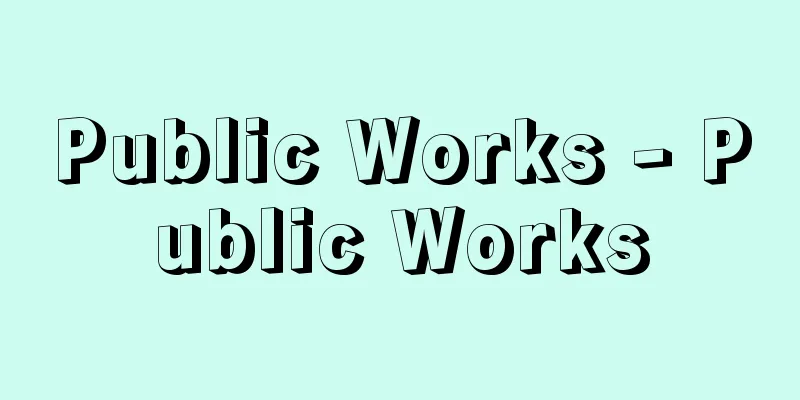Public Works - Public Works

|
It refers to the construction and maintenance of social capital undertaken by the national or local governments. Public investment, a related term, refers only to capital expenditures, whereas public works is a broader concept that includes research, planning and operation. Public works are broadly divided into three types according to their purpose: (1) Industrial infrastructure-related: The purpose is to improve production, such as by developing roads, ports, railways, and communication facilities. (2) Infrastructure for Living: These are aimed at improving the lives of the people, such as developing parks and water and sewerage systems, building schools, housing, and hospitals, and remodeling cities. (3) Land conservation-related: These aim to conserve the land, including forest and flood control and urban disaster prevention. In a capitalist economy, the efficient allocation of resources, one of the goals of economic policy, is achieved through the price mechanism in the market. However, since public businesses such as those mentioned above are goods and services that have external effects or have decreasing costs, or are pure public goods, it is impossible or inappropriate to leave them to the price mechanism. In other words, if left to private companies, there are goods and services that are not supplied at all or that are significantly insufficient compared to the amount socially demanded, so the government needs to take over the business activities instead. Looking at the progress of public works, we can see that they have constantly changed to reflect the social demands of the time. In the case of Japan, immediately after the Second World War, investment was focused on land conservation (mainly disaster recovery) and the agriculture, forestry and fisheries sectors in order to rebuild the country and increase food production, but during the period of high economic growth, while private capital accumulated rapidly, the lagging behind of social capital became noticeable, and investment was focused on industrial infrastructure such as roads and ports. However, with the oil shock (1973), the distortion caused by high economic growth began to be an issue, and in recent years, public investment has also been focused on infrastructure related to daily life such as sewers, parks and housing. Public works are not only carried out with the policy objective of efficient resource allocation, but also with the objective of economic stability (business cycle adjustment). The expansion of public works has the effect of increasing effective demand through the multiplier effect and raising the national income level. From this perspective, looking at the changes in the scale of public works in Japan, public works showed large increases every year during the economic stagnation period from 1966 (Showa 41), 1967, and from 1976 to 1979, but this can be judged to have been used as an economic stimulus measure. In contrast, the high growth in public works in the early 1970s was mainly aimed at correcting social distortions, and it cannot be said that it was necessarily necessary from the perspective of economic stimulus measures. Since 1980, the growth in public works-related expenses has been suppressed to zero. This is because the construction bonds issued since 1966 as a source of public works expenses have accumulated together with the deficit bonds issued since 1975, which have been putting pressure on the finances. Currently, from the perspective of stability policy, there is a debate as to whether the multiplier effect of public works or public investment is declining. One of the reasons is that the bonds issued for public investment put pressure on financial markets and raise interest rates (crowding out). Another reason is that the target of public works has changed from industrial infrastructure to infrastructure for daily life, causing the output coefficient of investment to fall. Areas that will require public works in the future include the development of housing in urban areas and the enhancement of social capital related to daily life. [Tsuguo Fujino] "Textbook of Public Finance" by Yasushi Iino et al. (1979, Yuhikaku) "Economic Analysis of Public Fiscal Expenditures" by Hiroaki Kaizuka (1971, Sobunsha) [Reference] | |Source: Shogakukan Encyclopedia Nipponica About Encyclopedia Nipponica Information | Legend |
|
国または地方公共団体が行う社会資本の建設および維持の事業をいう。類語としての公共投資は資本的支出だけをさすのに対して、公共事業はその調査・計画および運営なども含むより広い概念である。公共事業はその目的に応じて次の3種類に大別される。 (1)産業基盤関係 道路・港湾・鉄道・通信施設の整備など生産の向上を目的とするもの。 (2)生活基盤関係 公園・上下水道の整備、学校・住宅・病院の建設、都市の改造など国民生活の向上を目的とするもの。 (3)国土保全関係 治山・治水、都市の防災など国土の保全を目的とするもの。 資本主義経済では、市場における価格機構によって、経済政策の目標の一つである資源の効率的配分が達成される。しかし、前記のような公共性を有する事業は、外部効果をもつか、費用逓減(ていげん)する財・サービスであったり、純粋公共財であるため、価格機構にゆだねることは不可能ないし不適当なものである。つまり、民間企業にゆだねておいては、まったく供給されないか、社会的に需要される量からみて著しく不足する財・サービスが存在するため、政府がかわって事業活動を行う必要がある。 公共事業の内容の推移をみると、その時々の社会的要請を反映して絶えず変化してきている。わが国の場合をみると、第二次世界大戦直後は、国土復興と食糧増産のため、国土保全(主として災害復旧)と農林漁業部門への投資が重点的に行われたが、高度成長期になると、民間資本の急激な蓄積が進んだのに対し、社会資本の立ち後れが目だつようになり、道路、港湾などの産業基盤関係への重点投資が行われるようになった。しかし、オイル・ショック(1973)を契機として、高度成長によるひずみが問題にされだし、近年は下水道、公園、住宅などの生活基盤関係にも公共投資の重点が置かれるようになってきた。 公共事業は、資源の効率的配分という政策目的からなされるだけではなく、経済安定(景気調節)という目的からも実行される。公共事業の拡大は乗数効果を通じて有効需要を高め、国民所得水準を増大させる効果がある。このような観点から、わが国の公共事業の規模の推移をみると、公共事業は景気の停滞した1966年度(昭和41)、67年度および76年度以降79年度まで毎年度大幅な伸びを示しているが、これは景気対策として使われてきたと判断できる。これに対して70年代前半の高い公共事業の伸びは社会的ひずみの是正が主目的であって、景気対策という観点からみればかならずしも必要であったとはいいがたい。80年度以降は公共事業関係費の伸びがゼロに抑えられてきている。これは、公共事業費の財源として66年度以降発行されてきた建設国債が、75年度以降の赤字国債とともに累積し、それが財政を圧迫してきているためである。 現在、安定政策の観点から公共事業ないし公共投資の乗数効果が低下しているのではないかという議論がある。その理由の一つとして、公共投資を行うために発行する公債が金融市場を圧迫し、金利を上昇させる(クラウディング・アウト)という考えがあり、もう一つの理由として、公共事業の対象が産業基盤から生活基盤へと変化したために、投資の産出係数が低下したということも考えられている。今後、公共事業が必要となる分野として、都市地域における住宅の整備や生活関連社会資本の充実などが指摘されている。 [藤野次雄] 『飯野靖四他著『テキストブック財政学』(1979・有斐閣)』▽『貝塚啓明著『財政支出の経済分析』(1971・創文社)』 [参照項目] | |出典 小学館 日本大百科全書(ニッポニカ)日本大百科全書(ニッポニカ)について 情報 | 凡例 |
>>: Xingjiao Temple (English name)
Recommend
Taiko Hirabayashi - Taiko Hirabayashi
Novelist. Born in Nagano Prefecture on October 3,...
Myron (English spelling)
Ancient Greek wrestler in the late 6th century BCE...
Magnesium carbonate
Magnesium carbonate. Sometimes called charcoal-ma...
Abner
…After hearing that Saul had been defeated and ki...
Stick - stick (English spelling)
A walking stick. A corrupted form of the English ...
Dasté, J.
…He has written a collection of theater critiques...
Meaux (English spelling)
A city in the Seine-et-Marne department in norther...
EFEDouwes Dekker
1879‐1950 A leader of the Indonesian nationalist m...
Kawasaki-Mitsubishi Kobe Shipyard Dispute
It was the largest strike in Japan before World Wa...
Ushiku [city] - Ushiku
A city in southern Ibaraki Prefecture. It was inco...
Assistant - Hosanin
In legal proceedings, the term has different mean...
tyurya
...Today, except in special cases, there is littl...
Nectophryne
... Toads are found in wet places such as forests...
mumps
…An infectious disease caused by the mumps virus....
Bell pepper - Piman (English spelling)
A variety of sweet pepper with no hotness in the ...









